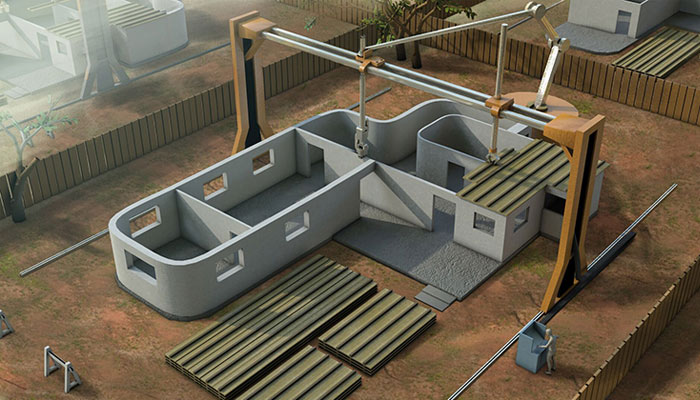The Evolution of Infrastructure with 3D Fabrication Breakthroughs
As we progress through the advancing domain of technology, one innovation stands prominently in the field of infrastructure: 3D printing. This exceptional approach is revolutionizing the method structures and edifices are designed and assembled, ushering in a new phase of effectiveness, environmental responsibility, and originality. Revolutionizing Construction: One Layer at a Moment The integration of 3D fabrication in infrastructure presents multiple game-changing advantages. Primary among these is the drastic decrease in substance surplus. Classic infrastructure techniques usually result in significant surplus resources that add to ecological depletion. In opposition, 3D manufacturing employs a accurate layer-by-layer approach, employing only the needed amount of material and thus reducing surplus significantly. Another significant advantage is the remarkable reduction in construction duration. Projects that traditionally demand extended durations can be finished in a fraction of the time with 3D fabrication innovations. This speed-up is due to the self-operating nature of 3D printers that can work 24/7 without manual assistance, greatly reducing complete project schedules. Moreover, 3D fabrication opens up possibilities for building sophisticated, personalized structures at no added cost. The flexibility of 3D printers enables for intricate designs and structures to be developed that would either be highly costly or unfeasible to achieve with standard construction approaches. This capability not only improves structural aesthetics but also allows builders to optimize plans for enhanced efficiency and longevity.  Lowering Costs and Enhancing Accessibility Expense cutting is yet another significant benefit delivered by 3D printing in construction. By reducing manpower expenses and slashing the duration required to complete undertakings, the complete cost linked to developing frameworks is lowered. Furthermore, low-cost 3D manufacturing units are getting more attainable, placing this technology within reach of emerging companies and independent creators enthusiastic to explore its potentials. The affordability of these units also paves the way for advancement in related fields such as fabric printing. While mainly known in infrastructure industries, the scope of 3D manufacturing extends into multiple areas including fashion. Here, artists innovate with 3D printed clothing, pushing creative constraints and reshaping fabric design while benefiting from cost-effective fabrication expenses. A Sustainable Vision Fueled by Progress Eco-friendliness is another pillar of this innovation’s value in the building industry. 3D fabrication supports a eco-conscious method to building by minimizing material surplus and resource consumption. Furthermore, it enables the integration of eco-friendly resources like recycled synthetics or blended materials, which further decreases the environmental impact of this traditionally heavy-polluting sector. The global shift towards eco-conscious practices discovers a reliable supporter in 3D fabrication innovations, likely transforming how architectural policies and criteria are formulated in the future. By implementing these advanced techniques, the building sector moves towards reaching greener functional strategies. Turning Dreams to Existence Imagine public hubs in low-income areas being built within a short time to address urgent demands or designers creating marvels reflecting organic patterns that merge seamlessly into their environments – such situations are not just theoretical but are fast becoming feasible through 3D printing. While these achievements signify just the beginning, they hint at a era where development integrates seamlessly with both human dreams and environmental care. If we continue on this path, infrastructure will not only mean the structural development of spaces but also symbolize a dedication to forward-thinking thinking and responsible living. Connecting artistry with functionality, 3D printing is ready to redefine our built reality in ways we are just beginning to comprehend. Through constant progress and an embracing of these futuristic strategies, our developed environments will undoubtedly morph into representations of societal creativity driven by the exactness and boundless possibilities of 3D fabrication. More information about may in soi nhuacheck out our web site
Lowering Costs and Enhancing Accessibility Expense cutting is yet another significant benefit delivered by 3D printing in construction. By reducing manpower expenses and slashing the duration required to complete undertakings, the complete cost linked to developing frameworks is lowered. Furthermore, low-cost 3D manufacturing units are getting more attainable, placing this technology within reach of emerging companies and independent creators enthusiastic to explore its potentials. The affordability of these units also paves the way for advancement in related fields such as fabric printing. While mainly known in infrastructure industries, the scope of 3D manufacturing extends into multiple areas including fashion. Here, artists innovate with 3D printed clothing, pushing creative constraints and reshaping fabric design while benefiting from cost-effective fabrication expenses. A Sustainable Vision Fueled by Progress Eco-friendliness is another pillar of this innovation’s value in the building industry. 3D fabrication supports a eco-conscious method to building by minimizing material surplus and resource consumption. Furthermore, it enables the integration of eco-friendly resources like recycled synthetics or blended materials, which further decreases the environmental impact of this traditionally heavy-polluting sector. The global shift towards eco-conscious practices discovers a reliable supporter in 3D fabrication innovations, likely transforming how architectural policies and criteria are formulated in the future. By implementing these advanced techniques, the building sector moves towards reaching greener functional strategies. Turning Dreams to Existence Imagine public hubs in low-income areas being built within a short time to address urgent demands or designers creating marvels reflecting organic patterns that merge seamlessly into their environments – such situations are not just theoretical but are fast becoming feasible through 3D printing. While these achievements signify just the beginning, they hint at a era where development integrates seamlessly with both human dreams and environmental care. If we continue on this path, infrastructure will not only mean the structural development of spaces but also symbolize a dedication to forward-thinking thinking and responsible living. Connecting artistry with functionality, 3D printing is ready to redefine our built reality in ways we are just beginning to comprehend. Through constant progress and an embracing of these futuristic strategies, our developed environments will undoubtedly morph into representations of societal creativity driven by the exactness and boundless possibilities of 3D fabrication. More information about may in soi nhuacheck out our web site